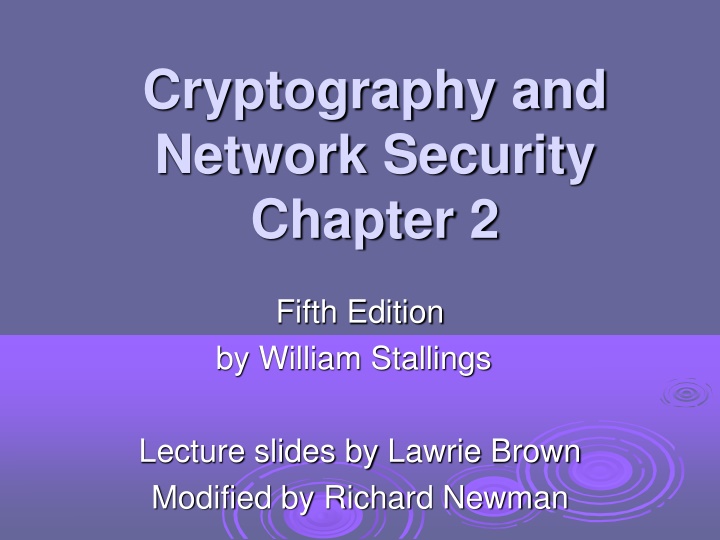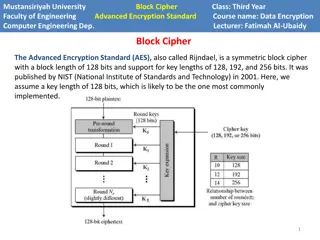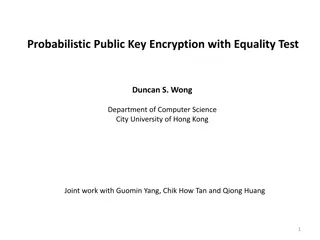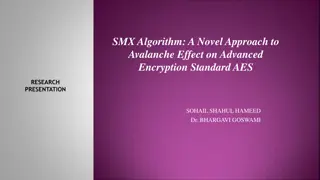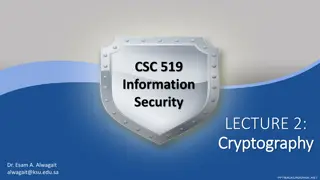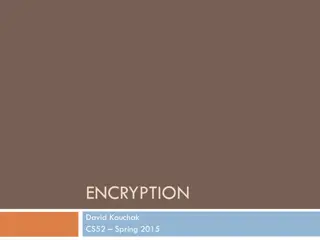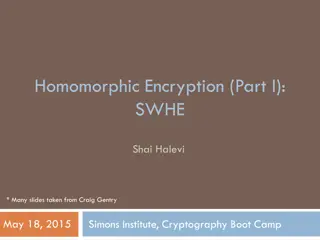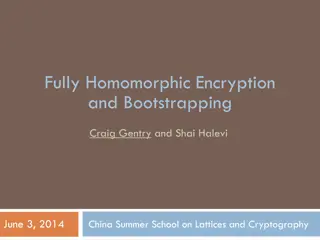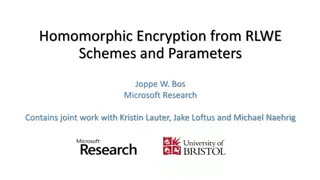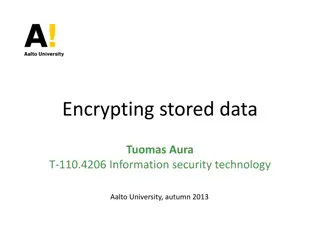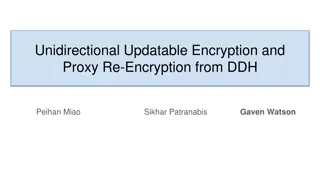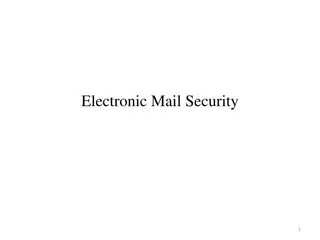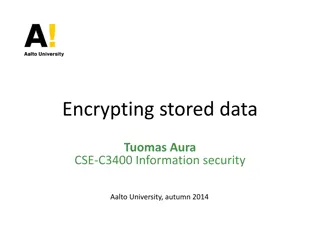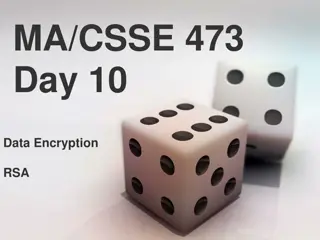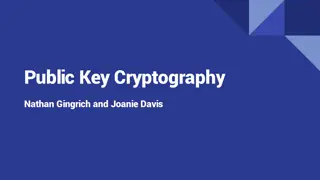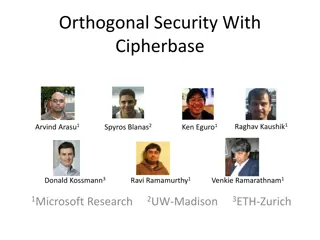Classical Encryption Techniques Overview
Delve into the realm of classical encryption techniques with insights on symmetric encryption, basic terminology, symmetric cipher model, and requirements for secure encryption. Explore the foundations of cryptography, different encryption operations, and the central problem in symmetric cryptography.
Download Presentation

Please find below an Image/Link to download the presentation.
The content on the website is provided AS IS for your information and personal use only. It may not be sold, licensed, or shared on other websites without obtaining consent from the author.If you encounter any issues during the download, it is possible that the publisher has removed the file from their server.
You are allowed to download the files provided on this website for personal or commercial use, subject to the condition that they are used lawfully. All files are the property of their respective owners.
The content on the website is provided AS IS for your information and personal use only. It may not be sold, licensed, or shared on other websites without obtaining consent from the author.
E N D
Presentation Transcript
Cryptography and Network Security Chapter 2 Fifth Edition by William Stallings Lecture slides by Lawrie Brown Modified by Richard Newman
Chapter 2 Classical Encryption Techniques "I am fairly familiar with all the forms of secret writings, and am myself the author of a trifling monograph upon the subject, in which I analyze one hundred and sixty separate ciphers," said Holmes.. The Adventure of the Dancing Men, Sir Arthur Conan Doyle
Symmetric Encryption or conventional / private-key / single-key sender and recipient share a common key all classical encryption algorithms are private-key was only type prior to invention of public- key in 1970 s and by far most widely used (still) is significantly faster than public-key crypto
Some Basic Terminology plaintext - original message ciphertext - coded message cipher - algorithm for transforming plaintext to ciphertext key - info used in cipher known only to sender/receiver encipher (encrypt) - converting plaintext to ciphertext decipher (decrypt) - recovering plaintext from ciphertext cryptography - study of encryption principles/methods cryptanalysis (codebreaking) - study of principles/ methods of deciphering ciphertext without knowing key cryptology - field of both cryptography and cryptanalysis
Requirements two requirements for secure use of symmetric encryption: a strong encryption algorithm a secret key known only to sender / receiver mathematically have: Y = E(K, X) = EK(X) = {X}K X = D(K, Y) = DK(Y) assume encryption algorithm is known Kerckhoff s Principle: security in secrecy of key alone, not in obscurity of the encryption algorithm implies a secure channel to distribute key Central problem in symmetric cryptography
Cryptography can characterize cryptographic system by: type of encryption operations used substitution transposition product number of keys used single-key or private two-key or public way in which plaintext is processed block stream
Cryptanalysis objective to recover key not just message general approaches: cryptanalytic attack brute-force attack if either succeed all key use compromised
Cryptanalytic Attacks ciphertext only only know algorithm & ciphertext, is statistical, can identify plaintext known plaintext know/suspect plaintext & ciphertext chosen plaintext select plaintext and obtain ciphertext chosen ciphertext select ciphertext and obtain plaintext chosen text select plaintext or ciphertext to en/decrypt
Cipher Strength unconditional security no matter how much computer power or time is available, the cipher cannot be broken since the ciphertext provides insufficient information to uniquely determine the corresponding plaintext computational security given limited computing resources (e.g. time needed for calculations is greater than age of universe), the cipher cannot be broken
Encryption Mappings A given key (k) Maps any message Mi to some ciphertext E(k,Mi) Ciphertext image of Mi is unique to Mi under k Plaintext pre-image of Ci is unique to Ci under k Notation key k and Mi in M, ! Cj in C such that E(k,Mi) = Cj key k and ciphertext Ci in C, ! Mj in M such that E(k,Mj) = Ci Ek(.) is one-to-one (injective) If |M|=|C| it is also onto (surjective), and hence bijective. M1 C1 K1 M2 C2 K1 K1 M3 C3 K1 A A K1 Mi Ci A A K1 Mn Cn M=set of all plaintexts C=set of all ciphertexts
Encryption Mappings (2) A given plaintext (Mi) Mi is mapped to some ciphertext E(K,Mi) by every key k Different keys may map Mi to the same ciphertext There may be some ciphertexts to which Mi is never mapped by any key Notation key k and Mi in M, ! ciphertext Cj in C such that E(k,Mi) = Cj It is possible that there are keys k and k such that E(k,Mi) = E(k ,Mi) There may be some ciphertext Cj for which key k such that E(k,Mi) = Cj M1 C1 Kj M2 C2 K2,K89,... K3,Kj ,... Km M3 C3 A A K1,K757,... Mi Ci Mn Cn
Encryption Mappings (3) A ciphertext (Ci) Has a unique plaintext pre- image under each k May have two keys that map the same plaintext to it There may be some plaintext Mj such that no key maps Mj to Ci Notation key k and ciphertext Ci in C, ! Mj in M such that E(k,Mj) = Ci There may exist keys k, k and plaintext Mj such that E(k,Mj) = E(k ,Mj) = Ci There may exist plaintext Mj such that key k such that E(k,Mj) = Ci M1 C1 K1,K17,... M2 C2 K2,K89,... M3 C3 Km K3,K94,... Kj ... ... ... A A Mi Ci ... ... ... Mn Cn
Encryption Mappings (4) Under what conditions will there always be some key that maps some plaintext to a given ciphertext? If for an intercepted ciphertext cj, there is some plaintext mi for which there does not exist any key k that maps mi to cj, then the attacker has learned something If the attacker has ciphertext cj and known plaintext mi, then many keys may be eliminated
Brute Force Search always possible to simply try every key most basic attack, exponential in key length assume either know / recognise plaintext Key Size (bits) Number of Alternative Keys Time required at 1 decryption/ s Time required at 106 decryptions/ s 232 = 4.3 109 32 231 s = 35.8 minutes 2.15 milliseconds 256 = 7.2 1016 56 255 s = 1142 years 10.01 hours 2128 = 3.4 1038 = 5.4 1024 years 5.4 1018 years 128 2127 s 2168 = 3.7 1050 = 5.9 1036 years 5.9 1030 years 168 2167 s 26! = 4 1026 2 1026 s = 6.4 1012 years 6.4 106 years 26 characters (permutation)
Classical Substitution Ciphers where letters of plaintext are replaced by other letters or by numbers or symbols or if plaintext is viewed as a sequence of bits, then substitution involves replacing plaintext bit patterns with ciphertext bit patterns
Caesar Cipher earliest known substitution cipher by Julius Caesar first attested use in military affairs replaces each letter by 3rd letter on example: meet me after the toga party PHHW PH DIWHU WKH WRJD SDUWB
Caesar Cipher can define transformation as: a b c d e f g h i j k l m n o p q r s t u v w x y z = IN D E F G H I J K L M N O P Q R S T U V W X Y Z A B C = OUT mathematically give each letter a number a b c d e f g h i j k l m n o p q r s t u v w x y z 0 1 2 3 4 5 6 7 8 9 10 11 12 13 14 15 16 17 18 19 20 21 22 23 24 25 then have Caesar (rotation) cipher as: c = E(k, p) = (p + k) mod (26) p = D(k, c) = (c k) mod (26)
Cryptanalysis of Caesar Cipher only have 26 possible ciphers A maps to A,B,..Z could simply try each in turn a brute force search given ciphertext, just try all shifts of letters do need to recognize when have plaintext eg. break ciphertext "GCUA VQ DTGCM"
Affine Cipher broaden to include multiplication can define affine transformation as: c = E(k, p) = (ap + b) mod (26) p = D(k, c) = (a-1c b) mod (26) key k=(a,b) a must be relatively prime to 26 so there exists unique inverse a-1
Affine Cipher - Example example k=(17,3): a b c d e f g h i j k l m n o p q r s t u v w x y z = IN D U L C T K B S J A R I Z Q H Y P G X O F W N E V M = OUT example: meet me after the toga party ZTTO ZT DKOTG OST OHBD YDGOV Now how many keys are there? 12 x 26 = 312 Still can be brute force attacked! Note: Example of product cipher
Monoalphabetic Cipher rather than just shifting the alphabet could shuffle (permute) the letters arbitrarily each plaintext letter maps to a different random ciphertext letter hence key is 26 letters long Plain: abcdefghijklmnopqrstuvwxyz Cipher: DKVQFIBJWPESCXHTMYAUOLRGZN Plaintext: ifwewishtoreplaceletters Ciphertext: WIRFRWAJUHYFTSDVFSFUUFYA
Monoalphabetic Cipher Security key size is now 25 characters now have a total of 26! = 4 x 1026 keys with so many keys, might think is secure but would be !!!WRONG!!! problem is language characteristics
Language Redundancy and Cryptanalysis human languages are redundant e.g., "th lrd s m shphrd shll nt wnt" letters are not equally commonly used in English E is by far the most common letter followed by T,R,N,I,O,A,S other letters like Z,J,K,Q,X are fairly rare have tables of single, double & triple letter frequencies for various languages
English Letter Frequencies Sorted Relative Frequencies 14.000 12.000 10.000 8.000 6.000 4.000 2.000 0.000 E T A O I N S H R D L C U M W F G Y P B V K J X Q Z
What kind of cipher is this? English Letter Frequencies 14.000 12.000 10.000 8.000 6.000 Frequences for Cipher-0 4.000 2.000 14.000 0.000 12.000 A B C D E F G H I J K L M N O P Q R S T U V W X Y Z 10.000 8.000 6.000 4.000 2.000 0.000 A B C D E F G H I J K L M N O P Q R S T U V W X Y Z
What kind of cipher is this? English Letter Frequencies 14.000 12.000 10.000 8.000 6.000 4.000 Frequencies for Cipher-1 2.000 14.000 0.000 12.000 A B C D E F G H I J K L M N O P Q R S T U V W X Y Z 10.000 8.000 6.000 4.000 2.000 0.000 A B C D E F G H I J K L M N O P Q R S T U V W X Y Z
Sorted English Letter Frequencies 14.000 12.000 10.000 8.000 6.000 Sorted Frequencies for Cipher-1 4.000 14.000 2.000 12.000 0.000 10.000 E T A O I N S H R D L C U M W F G Y P B V K J X Q Z 8.000 6.000 4.000 2.000 0.000 Q T A E O D I P R M B N Y G J C V K L S U W X H Z F
Use in Cryptanalysis key concept - monoalphabetic substitution ciphers do not change relative letter frequencies discovered by Arabian scientists in 9th century calculate letter frequencies for ciphertext compare counts/plots against known values if caesar cipher look for common peaks/troughs peaks at: A-E-I triple, N-O pair, R-S-T triple troughs at: J-K, U-V-W-X-Y-Z for monoalphabetic must identify each letter tables of common double/triple letters help (digrams and trigrams) amount of ciphertext is important statistics!
Example Cryptanalysis given ciphertext: UZQSOVUOHXMOPVGPOZPEVSGZWSZOPFPESXUDBMETSXAIZ VUEPHZHMDZSHZOWSFPAPPDTSVPQUZWYMXUZUHSX EPYEPOPDZSZUFPOMBZWPFUPZHMDJUDTMOHMQ count relative letter frequencies (see text)
Example Cryptanalysis given ciphertext: UZQSOVUOHXMOPVGPOZPEVSGZWSZOPFPESXUDBMETSXAIZ VUEPHZHMDZSHZOWSFPAPPDTSVPQUZWYMXUZUHSX EPYEPOPDZSZUFPOMBZWPFUPZHMDJUDTMOHMQ guess P & Z are e and t guess ZW is th and hence ZWP is the proceeding with trial and error finally get: it was disclosed yesterday that several informal but direct contacts have been made with political representatives of the viet cong in moscow
Playfair Cipher not even the large number of keys in a monoalphabetic cipher provides security one approach to improving security was to encrypt multiple letters the Playfair Cipher is an example invented by Charles Wheatstone in 1854, but named after his friend Baron Playfair
Playfair Key Matrix a 5X5 matrix of letters based on a keyword fill in letters of keyword (sans duplicates) fill rest of matrix with other letters eg. using the keyword MONARCHY M O N A R C H Y B D E F G I/J K L P Q S T U V W X Z
Encrypting and Decrypting plaintext is encrypted two letters at a time 1. if a pair is a repeated letter, insert filler like 'X 2. if both letters fall in the same row, replace each with letter to right (wrapping back to start from end) 3. if both letters fall in the same column, replace each with the letter below it (wrapping to top from bottom) 4. otherwise each letter is replaced by the letter in the same row and in the column of the other letter of the pair
Playfair Example Message = Move forward Plaintext = mo ve fo rw ar dx Here x is just a filler, message is padded and segmented mo -> ON; ve -> UF; fo -> PH, etc. Ciphertext = ON UF PH NZ RM BZ M O N A R C H Y B D E F G I/J K L P Q S T U V W X Z
Security of Playfair Cipher security much improved over monoalphabetic since have 26 x 26 = 676 digrams would need a 676 entry frequency table to analyse (versus 26 for a monoalphabetic) and correspondingly more ciphertext was widely used for many years eg. by US & British military in WW1 it can be broken, given a few hundred letters since still has much of plaintext structure
Polyalphabetic Ciphers polyalphabetic substitution ciphers improve security using multiple cipher alphabets make cryptanalysis harder with more alphabets to guess and flatter frequency distribution use a key to select which alphabet is used for each letter of the message use each alphabet in turn repeat from start after end of key is reached
Vigenre Cipher simplest polyalphabetic substitution cipher effectively multiple caesar ciphers key is multiple letters long K = k1 k2 ... kd ith letter specifies ith alphabet to use use each alphabet in turn repeat from start after d letters in message decryption simply works in reverse
Example of Vigenre Cipher write the plaintext out write the keyword repeated above it use each key letter as a caesar cipher key encrypt the corresponding plaintext letter eg using keyword deceptive key: deceptivedeceptivedeceptive plaintext: wearediscoveredsaveyourself ciphertext:ZICVTWQNGRZGVTWAVZHCQYGLMGJ
Aids simple aids can assist with en/decryption a Saint-Cyr Slide is a simple manual aid a slide with repeated alphabet line up plaintext 'A' with key letter, eg 'C' then read off any mapping for key letter can bend round into a cipher disk or expand into a Vigen re Tableau
Security of Vigenre Ciphers have multiple ciphertext letters for each plaintext letter hence letter frequencies are obscured but not totally lost start with letter frequencies see if it looks monoalphabetic or not if not, then need to determine number of alphabets, since then can attack each
Frequencies After Polyalphabetic Encryption Letter Relative Frequency 14.000 12.000 Column N Column O Column P Column Q Column R 10.000 8.000 6.000 4.000 2.000 0.000 B D F H J L N P R T V X Z A C E G I K M O Q S U W Y
Frequencies After Polyalphabetic Encryption Sorted relative frequencies 14 12 10 Column N Column O Column P Column Q Column R 8 6 4 2 0 1 2 3 4 5 6 7 8 9 1 1 1 1 2 1 3 1 4 1 5 1 6 1 7 1 8 1 9 2 0 2 1 2 2 2 3 2 4 2 5 2 6 0
Homework 1 Due Fri Question 1: What is the best flattening effect you can achieve by carefully selecting two monoalphabetic substitutions? Explain and give an example. What about three monoalphabetic substitutions?
Kasiski Method method developed by Babbage / Kasiski repetitions in ciphertext give clues to period so find same plaintext a multiple of key length apart which results in the same ciphertext of course, could also be random fluke e.g. repeated VTW in previous example distance of 9 suggests key size of 3 or 9 then attack each monoalphabetic cipher individually using same techniques as before
Example of Kasiski Attack Find repeated ciphertext trigrams (e.g., VTW) May be result of same key sequence and same plaintext sequence (or not) Find distance(s) Common factors are likely key lengths key: deceptivedeceptivedeceptive plaintext: wearediscoveredsaveyourself ciphertext:ZICVTWQNGRZGVTWAVZHCQYGLMGJ
Autokey Cipher ideally want a key as long as the message Vigen re proposed the autokey cipher with keyword is prefixed to message as key knowing keyword can recover the first few letters use these in turn on the rest of the message but still have frequency characteristics to attack eg. given key deceptive key: deceptivewearediscoveredsav plaintext: wearediscoveredsaveyourself ciphertext:ZICVTWQNGKZEIIGASXSTSLVVWLA
Homophone Cipher rather than combine multiple monoalphabetic ciphers, can assign multiple ciphertext characters to same plaintext character assign number of homophones according to frequency of plaintext character Gauss believed he made unbreakable cipher using homophones but still have digram/trigram frequency characteristics to attack e.g., have 58 ciphertext characters, with each plaintext character assigned to ceil(freq/2) ciphertext characters so e has 7 homophones, t has 5, a has 4, j has 1, q has 1, etc.
Vernam Cipher ultimate defense is to use a key as long as the plaintext with no statistical relationship to it invented by AT&T engineer Gilbert Vernam in 1918 specified in U.S. Patent 1,310,719, issued July 22, 1919 originally proposed using a very long but eventually repeating key used electromechanical relays
